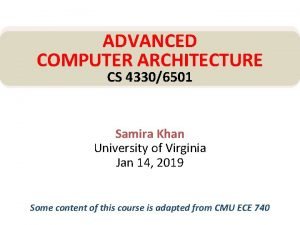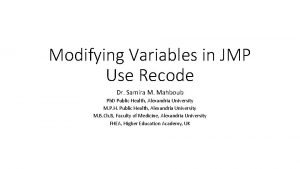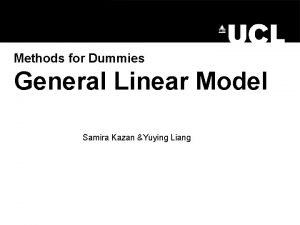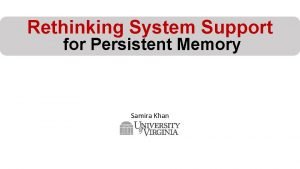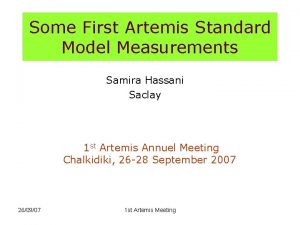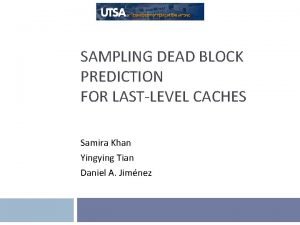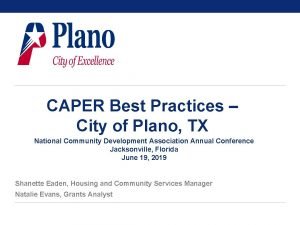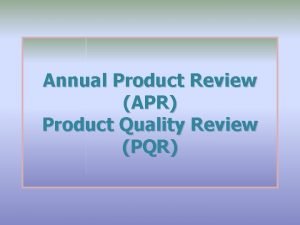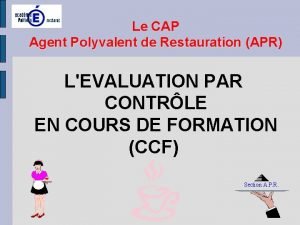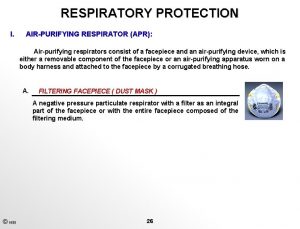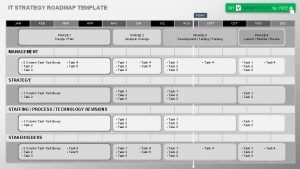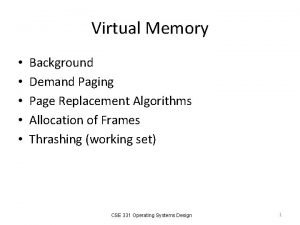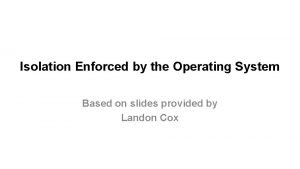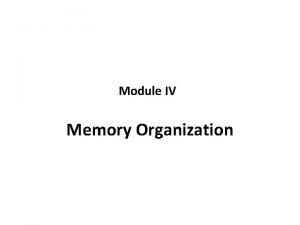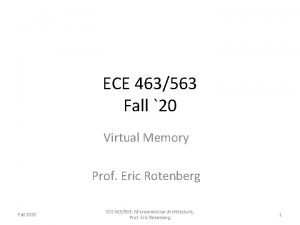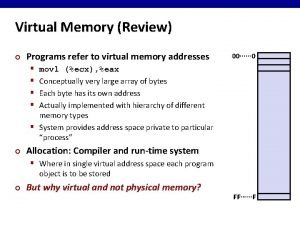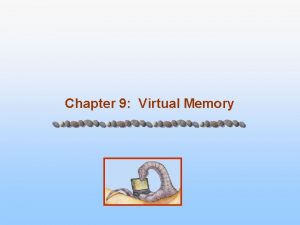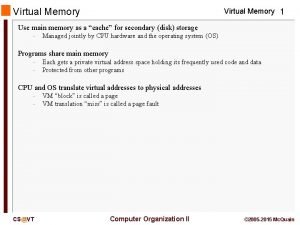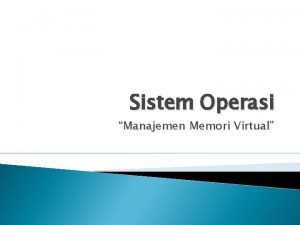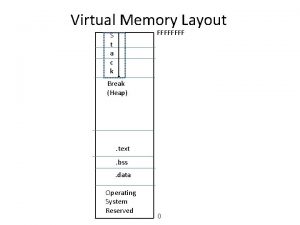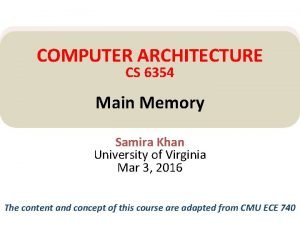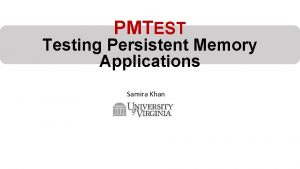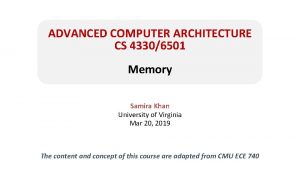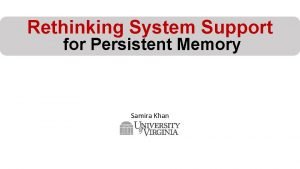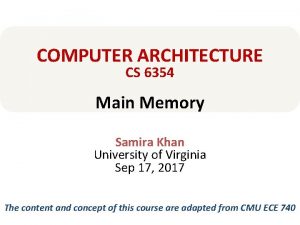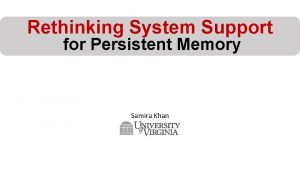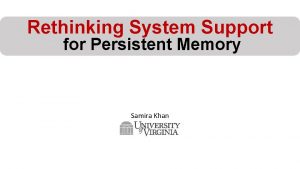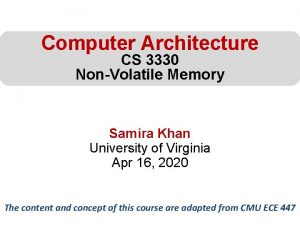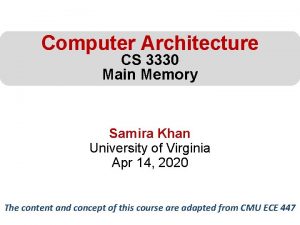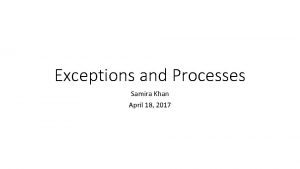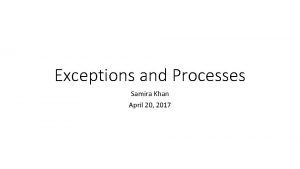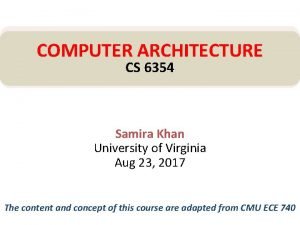Virtual Memory Samira Khan Apr 27 2017 1














![Translation: “Flat” Page Table pte_t PAGE_TABLE[1<<20]; // 32 -bit VA, 28 -bit PA, 4 Translation: “Flat” Page Table pte_t PAGE_TABLE[1<<20]; // 32 -bit VA, 28 -bit PA, 4](https://slidetodoc.com/presentation_image_h/7b7171011ca9295d42ffc2d36aee54ce/image-15.jpg)
![Translation: Two-Level Page Table pte_t *PAGE_DIRECTORY[1<<10]; PAGE_DIRECTORY[0]=malloc((1<<10)*sizeof(pte_t)); PAGE_DIRECTORY[0][7]=2; PAGE_DIR 31 PDE 1023 PDE 1 Translation: Two-Level Page Table pte_t *PAGE_DIRECTORY[1<<10]; PAGE_DIRECTORY[0]=malloc((1<<10)*sizeof(pte_t)); PAGE_DIRECTORY[0][7]=2; PAGE_DIR 31 PDE 1023 PDE 1](https://slidetodoc.com/presentation_image_h/7b7171011ca9295d42ffc2d36aee54ce/image-16.jpg)































- Slides: 47

Virtual Memory Samira Khan Apr 27, 2017 1

Virtual Memory • Idea: Give the programmer the illusion of a large address space while having a small physical memory • So that the programmer does not worry about managing physical memory • Programmer can assume he/she has “infinite” amount of physical memory • Hardware and software cooperatively and automatically manage the physical memory space to provide the illusion • Illusion is maintained for each independent process 2

Basic Mechanism • Indirection (in addressing) • Address generated by each instruction in a program is a “virtual address” • i. e. , it is not the physical address used to address main memory • An “address translation” mechanism maps this address to a “physical address” • Address translation mechanism can be implemented in hardware and software together “At the heart [. . . ] is the notion that ‘address’ is a concept distinct from ‘physical location. ’” Peter Denning 3

Overview of Paging 4 GB virtual 16 MB Ma physical g n i pp Virtual Page Process 2 Physical Page Frame 4 GB Process 1 virtual Virtual Page 4

Review: Virtual Memory & Physical Memory Virtual address Valid PTE 0 0 1 1 0 0 PTE 7 1 Physical page number or disk address null Physical memory (DRAM) VP 1 VP 2 VP 7 VP 4 PP 0 PP 3 Virtual memory (disk) VP 1 Memory resident page table (DRAM) VP 2 VP 3 VP 4 VP 6 VP 7 ¢ A page table contains page table entries (PTEs) that map virtual pages to physical pages. 5

Translation • Assume: Virtual Page 7 is mapped to Physical Page 32 • For an access to Virtual Page 7 … 31 Virtual Address: 12 11 0000000111 011001 VPN Offset Translate d 12 27 Physical Address: 0 11 0 0000100000 011001 PPN Offset 6

Address Translation. Virtual With a Page Table address n-1 Page table base register (PTBR) (CR 3 in x 86) p p-1 Virtual page number (VPN) 0 Virtual page offset (VPO) Page table Valid Physical page number (PPN) Physical page table address for the current process Valid bit = 0: Page not in memory (page fault) Valid bit = 1 m-1 Physical page number (PPN) p p-1 0 Physical page offset (PPO) Physical address 7

Address Translation: Page Hit 2 PTEA CPU Chip CPU 1 VA PTE MMU 3 PA Cache/ Memory 4 Data 5 1) Processor sends virtual address to MMU 2 -3) MMU fetches PTE from page table in memory 4) MMU sends physical address to cache/memory 5) Cache/memory sends data word to processor 8

Address Translation: Page Fault Exception 4 2 PTEA CPU Chip CPU 1 VA 7 Page fault handler MMU PTE 3 Victim page Cache/ Memory 5 Disk New page 6 1) Processor sends virtual address to MMU 2 -3) MMU fetches PTE from page table in memory 4) Valid bit is zero, so MMU triggers page fault exception 5) Handler identifies victim (and, if dirty, pages it out to disk) 6) Handler pages in new page and updates PTE in memory 7) Handler returns to original process, restarting faulting instruction 9

Integrating VM and Cache PTE CPU Chip PTEA CPU PTEA hit VA MMU PTEA miss PA PA miss PA Memory Data PA hit Data PTEA L 1 cache VA: virtual address, PA: physical address, PTE: page table entry, PTEA = PTE address 10

Two Problems • Two problems with page tables • Problem #1: Page table is too large • Problem #2: Page table is stored in memory • Before every memory access, always fetch the PTE from the slow memory? Large performance penalty 11

Multi-Level Page Tables • Suppose: • 4 KB (212) page size, 48 -bit address space, 8 -byte PTE • Problem: • Would need a 512 GB page table! • 248 * 2 -12 * 23 = 239 bytes Level 2 Tables Level 1 Table . . . • Common solution: Multi-level page table • Example: 2 -level page table • Level 1 table: each PTE points to a page table (always memory resident) • Level 2 table: each PTE points to a page (paged in and out like any other data) 12

A Two-Level Page Table Hierarchy Level 1 page table Level 2 page tables Virtual memory VP 0 PTE 1 . . . PTE 2 (null) PTE 1023 PTE 3 (null) PTE 0 PTE 5 (null) . . . PTE 6 (null) PTE 1023 VP 1024 2 K allocated VM pages for code and data . . . Gap PTE 7 (null) (1 K - 9) null PTEs . . . VP 2047 PTE 4 (null) PTE 8 0 6 K unallocated VM pages 1023 null PTEs PTE 1023 . . . 32 bit addresses, 4 KB pages, 4 -byte PTEs 1023 unallocated pages VP 9215 1023 unallocated pages 1 allocated VM page for the stack 13

Translating with a k-level Page Table Page table base register (PTBR) VIRTUAL ADDRESS n-1 VPN 2 the Level 1 page table a Level 2 page table . . . VPN k . . . p-1 VPO 0 p-1 PPO 0 a Level k page table PPN m-1 PPN PHYSICAL ADDRESS 14
![Translation Flat Page Table ptet PAGETABLE120 32 bit VA 28 bit PA 4 Translation: “Flat” Page Table pte_t PAGE_TABLE[1<<20]; // 32 -bit VA, 28 -bit PA, 4](https://slidetodoc.com/presentation_image_h/7b7171011ca9295d42ffc2d36aee54ce/image-15.jpg)
Translation: “Flat” Page Table pte_t PAGE_TABLE[1<<20]; // 32 -bit VA, 28 -bit PA, 4 KB page PAGE_TABLE[7]=2; PAGE_TABLE 15 0 PTE 1<<20 -1 PTE 7 ··· NULL 000000010 NULL 31 12 11 0 000000111 XXX VPN ··· NULL Virtual Address PTE 1 PTE 0 Offset Physical Address 27 12 11 0 000000010 XXX PPN Offset 15
![Translation TwoLevel Page Table ptet PAGEDIRECTORY110 PAGEDIRECTORY0malloc110sizeofptet PAGEDIRECTORY072 PAGEDIR 31 PDE 1023 PDE 1 Translation: Two-Level Page Table pte_t *PAGE_DIRECTORY[1<<10]; PAGE_DIRECTORY[0]=malloc((1<<10)*sizeof(pte_t)); PAGE_DIRECTORY[0][7]=2; PAGE_DIR 31 PDE 1023 PDE 1](https://slidetodoc.com/presentation_image_h/7b7171011ca9295d42ffc2d36aee54ce/image-16.jpg)
Translation: Two-Level Page Table pte_t *PAGE_DIRECTORY[1<<10]; PAGE_DIRECTORY[0]=malloc((1<<10)*sizeof(pte_t)); PAGE_DIRECTORY[0][7]=2; PAGE_DIR 31 PDE 1023 PDE 1 PDE 0 0 PAGE_TABLE 0 15 NULL 0 NULL 0 &PT PTE 1023 000000010 NULL PTE 7 NULL PTE 0 VPN[31: 12]=00000_0000000111 Directory index Table index 16

Two-Level Page Table (x 86) • CR 3: Control Register 3 (or Page Directory Base Register) • Stores the physical address of the page directory • Q: Why not the virtual address? 17

Multi-Level Page Table (x 86 -64) 18

Per-Process Virtual Address Space • Each process has its own virtual address space • Process X: text editor • Process Y: video player • X writing to its virtual address 0 does not affect the data stored in Y’s virtual address 0 (or any other address) • This was the entire purpose of virtual memory • Each process has its own page directory and page tables • On a context switch, the CR 3’s value must be updated X’s PAGE_DIR Y’s PAGE_DIR CR 3 19

Two Problems • Two problems with page tables • Problem #1: Page table is too large • Page table has 1 M entries • Each entry is 4 B (because 4 B ≈ 20 -bit PPN) • Page table = 4 MB (!!) • very expensive in the 80 s • Solution: Hierarchical page table • Problem #2: Page table is in memory • Before every memory access, always fetch the PTE from the slow memory? Large performance penalty 20

Speeding up Translation with a TLB • Page table entries (PTEs) are cached in L 1 like any other memory word • PTEs may be evicted by other data references • PTE hit still requires a small L 1 delay • Solution: Translation Lookaside Buffer (TLB) • Small set-associative hardware cache in MMU • Maps virtual page numbers to physical page numbers • Contains complete page table entries for small number of pages 21

Accessing the TLB • MMU uses the VPN portion of the virtual address to access the TLB: T = 2 t sets VPN TLBT matches tag of n-1 p+t-1 p p-1 0 line within set TLB tag (TLBT) TLB index (TLBI) VPO Set 0 v tag v PTE tag PTE TLBI selects the set v tag PTE Set T-1 v tag PTE … Set 1 22

TLB Hit CPU Chip CPU TLB 2 PTE VPN 3 1 VA MMU PA 4 Cache/ Memory Data 5 A TLB hit eliminates a memory access 23

TLB Miss CPU Chip TLB 2 4 PTE VPN CPU 1 VA MMU 3 PTEA PA Cache/ Memory 5 Data 6 A TLB miss incurs an additional memory access (the PTE) Fortunately, TLB misses are rare. Why? 24

Simple Memory System Example • Addressing • 14 -bit virtual addresses • 12 -bit physical address • Page size = 64 bytes 13 12 11 10 9 8 7 6 5 4 3 2 1 VPN VPO Virtual Page Number Virtual Page Offset 11 10 9 8 7 6 5 4 3 2 1 PPN PPO Physical Page Number Physical Page Offset 0 0 25

Simple Memory System TLB • 16 entries • 4 -way associative TLBT TLBI 13 12 11 10 9 8 7 6 0 0 1 1 0 1 5 4 3 2 1 0 VPO VPN = 0 b 1101 PPN = ? Translation Lookaside Buffer (TLB) Set Tag PPN Valid 0 03 – 0 09 0 D 1 00 – 0 07 02 1 1 03 2 D 1 02 – 0 04 – 0 0 A – 0 2 02 – 0 08 – 0 06 – 0 03 – 0 3 07 – 0 03 0 D 1 0 A 34 1 02 – 0 26

Simple Memory System Page Table Only showing the first 16 entries (out of 256) VPN = 0 b 1101 PPN = ? VPN PPN Valid 00 28 1 08 13 1 01 – 0 09 17 1 02 33 1 0 A 09 1 03 02 1 0 B – 0 04 – 0 0 C – 0 05 16 1 0 D 2 D 1 06 – 0 0 E 11 1 07 – 0 0 F 0 D 1 0 x 0 D → 0 x 2 D 27

Context Switches • Assume that Process X is running • Process X’s VPN 5 is mapped to PPN 100 • The TLB caches this mapping • VPN 5 PPN 100 • Now assume a context switch to Process Y • Process Y’s VPN 5 is mapped to PPN 200 • When Process Y tries to access VPN 5, it searches the TLB • Process Y finds an entry whose tag is 5 • Hurray! It’s a TLB hit! • The PPN must be 100! • … Are you sure? 28

Context Switches (cont’d) • Approach #1. Flush the TLB • Whenever there is a context switch, flush the TLB • All TLB entries are invalidated • Example: 80836 • Updating the value of CR 3 signals a context switch • This automatically triggers a TLB flush • Approach #2. Associate TLB entries with processes • All TLB entries have an extra field in the tag. . . • That identifies the process to which it belongs • Invalidate only the entries belonging to the old process • Example: Modern x 86, MIPS 29

Handling TLB Misses • The TLB is small; it cannot hold all PTEs • Some translations will inevitably miss in the TLB • Must access memory to find the appropriate PTE • Called walking the page directory/table • Large performance penalty • Who handles TLB misses? 1. Hardware-Managed TLB 2. Software-Managed TLB 30

Handling TLB Misses (cont’d) • Approach #1. Hardware-Managed (e. g. , x 86) • The hardware does the page walk • The hardware fetches the PTE and inserts it into the TLB • If the TLB is full, the entry replaces another entry • All of this is done transparently • Approach #2. Software-Managed (e. g. , MIPS) • • The hardware raises an exception The operating system does the page walk The operating system fetches the PTE The operating system inserts/evicts entries in the TLB 31

Handling TLB Misses (cont’d) • Hardware-Managed TLB • • Pro: No exceptions. Instruction just stalls Pro: Independent instructions may continue Pro: Small footprint (no extra instructions/data) Con: Page directory/table organization is etched in stone • Software-Managed TLB • • Pro: The OS can design the page directory/table Pro: More advanced TLB replacement policy Con: Flushes pipeline Con: Performance overhead 32

Address Translation and Caching • When do we do the address translation? • Before or after accessing the L 1 cache? • In other words, is the cache virtually addressed or physically addressed? • Virtual versus physical cache • What are the issues with a virtually addressed cache? • Synonym problem: • Two different virtual addresses can map to the same physical address can be present in multiple locations in the cache can lead to inconsistency in data 33

Homonyms and Synonyms • Homonym: Same VA can map to two different PAs • Why? • VA is in different processes • Synonym: Different VAs can map to the same PA • Why? • Different pages can share the same physical frame within or across processes • Reasons: shared libraries, shared data, copy-on-write pages within the same process, … • Do homonyms and synonyms create problems when we have a cache? • Is the cache virtually or physically addressed? 34

Cache-VM Interaction CPU TLB CPU VA PA CPU cache tlb lower hier. physical cache tlb VA PA virtual (L 1) cache lower hier. virtual-physical cache 35

Virtually-Indexed Physically-Tagged • If C≤(page_size associativity), the cache index bits come only from page offset (same in VA and PA) • If both cache and TLB are on chip • index both arrays concurrently using VA bits • check cache tag (physical) against TLB output at the end VPN Page Offset CIndex CO TLB PPN TLB hit? physical cache = tag cache hit? data 36

Virtually-Indexed Physically-Tagged • If C>(page_size associativity), the cache index bits include VPN Synonyms can cause problems • The same physical address can exist in two locations • Solutions? VPN Page Offset Cache Index CO a TLB PPN TLB hit? = physical cache tag data cache hit? 37

Sanity Check • Core 2 Duo: 32 KB, 8 -way set associative, page size ≥ 4 K • Cache size ≤(page_size associativity)? • 2 P = 4 K P = 12 • Needs 12 bits for page offset • 2 C = 32 KB, C = 15 • Needs 15 bits to address a byte in the cache • 2 A = 8 -way, A = 3 • Increasing the associativity of the cache reduces the number of address bits needed to index into the cache • Needs 12 bits for cache index and offset, as tags are matched for blocks in the same set • C≤P+A? 15 ≤ 12+3? True 38

Some Solutions to the Synonym Problem • Limit cache size to (page size times associativity) • get index from page offset • On a write to a block, search all possible indices that can contain the same physical block, and update/invalidate • Used in Alpha 21264, MIPS R 10 K • Restrict page placement in OS • make sure index(VA) = index(PA) • Called page coloring • Used in many SPARC processors 39

Today • Case study: Core i 7/Linux memory system 40

Intel Core i 7 Memory System Processor package Core x 4 Registers Instruction fetch L 1 d-cache 32 KB, 8 -way L 1 i-cache 32 KB, 8 -way L 2 unified cache 256 KB, 8 -way MMU (addr translation) L 1 d-TLB 64 entries, 4 -way L 1 i-TLB 128 entries, 4 -way L 2 unified TLB 512 entries, 4 -way Quick. Path interconnect 4 links @ 25. 6 GB/s each L 3 unified cache 8 MB, 16 -way (shared by all cores) To other cores To I/O bridge DDR 3 Memory controller 3 x 64 bit @ 10. 66 GB/s 32 GB/s total (shared by all cores) Main memory 41

End-to-end Core i 7 Address Translation 32/64 CPU L 2, L 3, and main memory Result Virtual address (VA) 36 12 VPN VPO 32 L 1 miss L 1 hit 4 TLBT TLBI L 1 d-cache (64 sets, 8 lines/set) TLB hit . . . TLB miss L 1 TLB (16 sets, 4 entries/set) 9 9 40 VPN 1 VPN 2 VPN 3 VPN 4 PPN CR 3 PTE PTE Page tables PTE 12 40 6 6 PPO CT CI CO Physical address (PA) 42

Speeding Up L 1 Access CT Physical address (PA) Virtual address (VA) • Observation • • • 40 CT 6 6 CI CO PPN PPO Tag Check No Change Address Translation CI VPN VPO 36 12 L 1 Cache Bits that determine CI identical in virtual and physical address Can index into cache while address translation taking place Generally we hit in TLB, so PPN bits (CT bits) available next “Virtually indexed, physically tagged” Cache carefully sized to make this possible

Core i 7 Level 1 -3 Page Table Entries 63 62 XD 52 51 Unused 12 11 Page table physical base address 9 Unused 8 7 G PS 6 5 A 4 3 2 1 0 CD WT U/S R/W P=1 Available for OS (page table location on disk) P=0 Each entry references a 4 K child page table. Significant fields: P: Child page table present in physical memory (1) or not (0). R/W: Read-only or read-write access permission for all reachable pages. U/S: user or supervisor (kernel) mode access permission for all reachable pages. WT: Write-through or write-back cache policy for the child page table. A: Reference bit (set by MMU on reads and writes, cleared by software). PS: Page size either 4 KB or 4 MB (defined for Level 1 PTEs only). Page table physical base address: 40 most significant bits of physical page table address (forces page tables to be 4 KB aligned) XD: Disable or enable instruction fetches from all pages reachable from this PTE. 44

Core i 7 Level 4 Page Table Entries 63 62 XD 52 51 Unused 12 11 Page physical base address 9 Unused 8 G 7 6 5 D A Available for OS (page location on disk) 4 3 2 1 0 CD WT U/S R/W P=1 P=0 Each entry references a 4 K child page. Significant fields: P: Child page is present in memory (1) or not (0) R/W: Read-only or read-write access permission for child page U/S: User or supervisor mode access WT: Write-through or write-back cache policy for this page A: Reference bit (set by MMU on reads and writes, cleared by software) D: Dirty bit (set by MMU on writes, cleared by software) Page physical base address: 40 most significant bits of physical page address (forces pages to be 4 KB aligned) XD: Disable or enable instruction fetches from this page. 45

Core i 7 Page Table Translation 9 9 VPN 1 CR 3 Physical address of L 1 PT 40 / L 1 PT Page global directory L 1 PTE 512 GB region per entry 9 VPN 2 L 2 PT Page upper 40 directory / VPN 3 L 3 PT Page middle 40 directory / L 2 PTE 9 VPN 4 2 MB region per entry VPO Virtual address L 4 PT Page table 40 / Offset into /12 physical and virtual page L 4 PTE L 3 PTE 1 GB region per entry 12 4 KB region per entry Physical address of page 40 / 40 12 PPN PPO Physical address 46

Virtual Memory Samira Khan Apr 27, 2017 47
 Samira khan uva
Samira khan uva Samira khan uva
Samira khan uva Dr samira khan
Dr samira khan Virtual memory in memory hierarchy consists of
Virtual memory in memory hierarchy consists of Page fault
Page fault Samira kazan
Samira kazan How to counter samira
How to counter samira Samira soltani
Samira soltani Samira hassani
Samira hassani Samira kazan origin
Samira kazan origin Samira zegrari
Samira zegrari Samira block
Samira block Apr vs ear
Apr vs ear What does apr stand for
What does apr stand for àpr
àpr Ncaa apr database
Ncaa apr database Sistem za centralizovano prijavljivanje korisnika apr
Sistem za centralizovano prijavljivanje korisnika apr Apr vs ear
Apr vs ear Apr pqr
Apr pqr Cours cap apr
Cours cap apr Apr vs ear
Apr vs ear Apr air purifying respirator
Apr air purifying respirator Jan feb mar
Jan feb mar Asco 2017 virtual meeting
Asco 2017 virtual meeting Long term memory vs short term memory
Long term memory vs short term memory Internal memory and external memory
Internal memory and external memory Which memory is the actual working memory?
Which memory is the actual working memory? Episodic memory vs semantic memory
Episodic memory vs semantic memory Primary memory and secondary memory
Primary memory and secondary memory Eidetic memory vs iconic memory
Eidetic memory vs iconic memory Excplicit memory
Excplicit memory Shared memory vs distributed memory
Shared memory vs distributed memory Physical address vs logical address
Physical address vs logical address Tlb
Tlb Virtual memory
Virtual memory Virtual memory os
Virtual memory os What is virtual memory
What is virtual memory Paged segmentation
Paged segmentation Virtual memory organization
Virtual memory organization Virtual memory
Virtual memory Tlb computer architecture
Tlb computer architecture Virtual address
Virtual address Virtual memory os
Virtual memory os Virtual memory in os
Virtual memory in os Virtual memory meaning
Virtual memory meaning Process virtual address space
Process virtual address space Apa karakteristik dari memori virtual
Apa karakteristik dari memori virtual Virtual memory layout
Virtual memory layout

